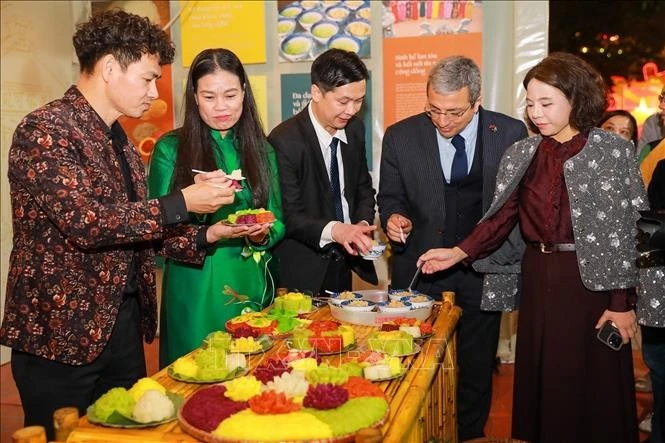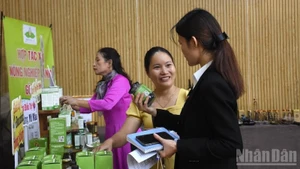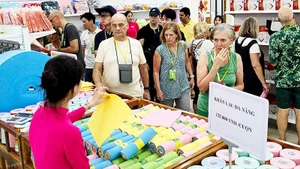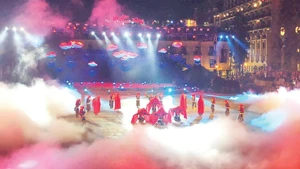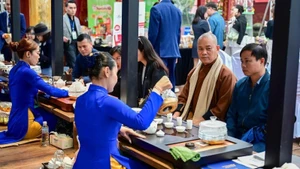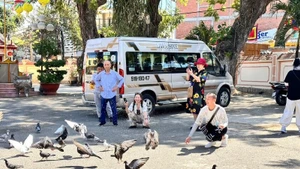Quan Son District is located in the western part of Thanh Hoa Province and features the Na Meo International Border Gate, which is a trading gateway with Laos. The forest coverage in the district exceeds 80%. The area boasts nearly 200 caves, streams, and waterfalls, along with many scenic spots and festivals associated with the lives of four ethnic groups (with the Thai people being the most numerous, accounting for nearly 82% of the population). The Bo Cung Cave wonder, the Pha Lo Bridge historical site, the Muong Xia Festival, the Na Meo Border Market, and the Ngam Village brocade weaving craft have contributed to Quan Son’s tourism potential, especially in community-based tourism and cave exploration. Ngam Village (Son Dien Commune) is a Thai ethnic village with nearly 80 households, 20 of which have registered to provide lodging, dining, and other services for visitors.
The highlight of the community-based tourism in Ngam Village is the Thai ethnic culture, including stilt house architecture, cuisine, songs, and traditional hand-weaving by women. Vi Thi Doanh (57), a homestay owner in the village and a passionate weaving artisan, shared that Thai women of her generation could weave and sew clothes for themselves and their families. Today, the weaving craft faces the risk of fading away as people have quicker and cheaper options, but it is crucial to preserve the craft as it embodies the cultural essence passed down through generations. Doanh has been encouraging villagers to keep their weaving looms, teach the craft to the younger generation, and strive to seek markets for their woven products as commercial goods, including decorative items and souvenirs for tourists. Visitors to Ngam Village not only have the opportunity to admire the pristine beauty of the highlands but also immerse themselves in the local lifestyle, learn about the fabric dyeing and weaving processes, engage in cultural exchanges, and purchase unique Thai ethnic products.
Mentioning Quan Son, one cannot overlook its many beautiful caves such as Bo Cung Cave, Nang Non Cave, Pha Bai Cave, Co Lay Cave, and Pha Khua Cave. The most famous of which is Bo Cung Cave (in Son Thuy Commune), which stretches over 1 km with a shimmering and magnificent stalactite system. In 2023, the Quan Son District People's Committee conducted surveys and assessments in collaboration with the British Royal Cave Research Association in Vietnam and released many important details about its outstanding values.
The cave, which was formed 4 million years ago, is located at an altitude of 420 metres above sea level, with many beautiful stalagmites that are significant for both scientific research and tourism development. Quan Son District has been investing in the construction and promotion of Bo Cung Cave, making it an attractive destination that welcomes tens of thousands of visitors each year. Not far from the cave is another famous spiritual site in Quan Son District including the Temple dedicated to General Tu Ma Hai Dao, a historical figure who contributed to defending the country against invaders and protecting the territory. He was a Thai ethnic person who lived in the 15th century during the Le So period. When Le Loi led the uprising against the Ming invaders, he joined the insurgent army and achieved many military victories, guarding the border and earning the title of Tu Ma (a military rank at that time).
Associated with the Temple of Tu Ma Hai Dao is the Muong Xia Festival, which was recognised by the Ministry of Culture, Sports, and Tourism as a national intangible cultural heritage in 2022. The festival is an important cultural and religious activity for the local people, with solemn and sacred ceremonies that have been maintained for many centuries. Following the rituals is a lively festival that features Thai ethnic group’s traditions with folk games and cultural activities.
Community-based tourism that allows visitors to experience Thai ethnic culture has been also gradually emerging in Tong Village (in Trung Tien Commune) and Khan Village (in Trung Thuong Commune) thanks to favourable natural conditions such as Pha Dua Mountain, Xia Stream, lush rice fields, and simple wooden houses on stilts. However, tourism activities in Quan Son District still face many bottlenecks and have not developed in line with their potential. Some difficulties include the remote location and lack of connectivity with inter-regional tourism routes, failure to attract major and synchronised investment from enterprises, insufficient and weak tourism workforce, simplistic and unattractive tourism products, inadequate accommodation facilities, and limited efforts in promoting and marketing.
Recognising tourism development as the right direction contributing to the locality’s socio-economic development, addressing hunger, reducing poverty, and improving people's quality of life, the Quan Son District authorities have approved several projects such as: “Community-based tourism development project in Quan Son District by 2025, with a vision towards 2030”; “Organic tourism development combined with eco-tourism in Quan Son District by 2025, aiming for 2030”; and the tourism development plan for Quan Son District by 2025. A positive signal is that since 2023, destinations around the district have welcomed 135,000 visitors. According to Le Hong Quang, Chairman of Quan Son District People's Committee, the district has invested nearly 10 billion VND in tourism development over the past two years, including supporting investment in community-based tourism sites and upgrading roads to Ngam Village; bringing the electricity grid to and constructing a management house at the Bo Cung Cave tourist area; and enhancing the landscape of Tu Ma Hai Dao Temple.
The district has also actively called for investment and created favourable conditions for enterprises engaged in community-based and exploratory tourism. In addition, promotion, mobilisation, and awareness-raising have been boosted among residents regarding participation in sustainable tourism development linked to environmental protection as well as the preservation and promotion of traditional culture. Leveraging its international border position, Quan Son District also promises to play a significant role in connecting tours with Houaphanh Province (Laos) in the near future.




